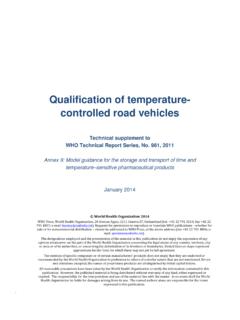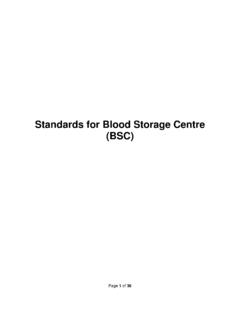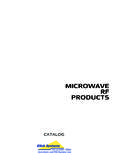Transcription of Where does Controlled Room Temperature Fit in …
1 LOGISTICS & SUPPLY CHAIN MANAGEMENT 70 INTERNATIONAL PHARMACEUTICAL INDUSTRY Spring 2014 Volume 6 Issue 1 Where does Controlled room Temperature Fit in the Cold Chain?There have been many attempts over the years to produce a one-size-fits-all Temperature profile against which to qualify Temperature - Controlled packaging (TCP), and many users argue a more lane-specific approach based on empirical data is required. While users and suppliers continue to demonstrate why one profile is more realistic than another, one question has gone under the radar for too long: to what Temperature profile should a 15-25 C (or Controlled room Temperature as it s often referred to) shipper be qualified?Across the board, Controlled room Temperature (CRT) solutions have been qualified against a completely different set of profiles than 2-8 C counterparts. Look at any Temperature - Controlled packaging supplier portfolio, or within a TCP user, and you will find similar variations and stresses within the qualification profile for cold chain shipping.
2 However, for CRT shipments sent from the same location, to the same destinations, via the same logistics network, a completely different qualification profile is used to quantify the the introduction of the new GDP guidelines last September, this inconsistency is becoming more evident as the attention begins to focus on CRT shipments and the requirement to ship within label conditions. CRT shipments that were shipped unmonitored and in uncontrolled packaging are now creating tension as the need to demonstrate Temperature compliance uncovers a hidden world of is stated in the guidelines: CHAPTER 9 TRANSPORTATION Principle Regardless of the mode of transport, it should be possible to demonstrate that the medicines have not been exposed to conditions that may compromise their quality and integrity. A risk-based approach should be utilised when planning transportation.
3 Now that you are using CRT qualified packaging have you ever wondered why your 96-hour qualified CRT solution goes out of specification after just two days? Historically, water-based CRT solutions have been qualified in a different manner than 2-8 C solutions. They are not designed to control the Temperature between 15-25 C degrees, in fact there is no Temperature control going on inside a water-based 15-25 C solution. The qualification process has been adapted to reflect this. If you take the time to compare the qualification Temperature profiles of 2-8 C and 15-25 C solutions that utilise water-based coolant for the same payload and duration, say 96 hours, you will find that a different Temperature 72 INTERNATIONAL PHARMACEUTICAL INDUSTRY LOGISTICS & SUPPLY CHAIN MANAGEMENT Spring 2014 Volume 6 Issue 1profile was used in the qualification process.
4 Shown here the CRT profile example and ISTA 7D profile both have a duration of 96 hours and Temperature extremes of +35 C, and -5 C and -10 C respectively, it is clear to see that one profile offers a much greater thermal challenge. Yet, any CRT packaging solution qualified to the above CRT profile can claim to be qualified for 96 hours for temperatures ranging from -5 C to +35 is quite evident that a 2-8 C qualified shipper has been designed to provide protection against a specific Temperature profile for a specific duration, while the reverse can be said for the CRT solution. It is the profile that has been designed around the capabilities of the shipper in order to produce a solution that performs for the desired length of you have two shipments, one 2-8 C and one 15-25 C, going to Singapore from London for example, on the same day with the same carrier, you can be pretty confident that both shipments are going to experience the same ambient temperatures during their journeys to Singapore.
5 So why have they been qualified to different Temperature profiles? If you dig a little deeper, you will find water-based CRT solutions provide no Temperature control, only thermal ballast and insulation. As soon as the shipper is placed in a different Temperature environment, the internal Temperature will begin to change. This is because there is no change of phase to absorb the energy differential. If you analyse the Temperature profile you may find there is a lot of time spent at 20 C with short spikes above and below the 15-25 C boundaries. On closer inspection you will see this time is used to recover the internal Temperature to prolong the qualified duration while allowing the manufacturer to make bold claims about shipper performance against extreme highs and lows of the average temperatures of the CRT and ISTA 7D profiles shown above really demonstrates the narrow band a water-based CRT solution is qualified to work within.
6 The new regulations remind us that it is the responsibility of the wholesale distributor to ensure that vehicles and equipment used to distribute, store or handle medicinal products are suitable for their use and appropriately equipped to prevent exposure of the products to conditions that could affect their quality. ( )1In order to get your 96-hour water-based solution to work and last 96 hours, the logistics environment it is exposed to during transit must be Controlled within its qualified parameters. This requires working with your logistics vendor to ensure special handling instructions are received and understood, and care is taken on lane selection and at key touch reality is, if you re using a water-based solution and your product cannot experience any Temperature deviations, you should be using a dedicated healthcare courier to provide the conditions to which the shipper has been qualified.
7 This is reaffirmed again in the new GDP regulations: CHAPTER 9 TRANSPORTATION Containers, packaging and labelling Selection of a container and packaging should be based on the storage and transportation requirements of the medicinal products; the space required for the amount of medicines; the anticipated external Temperature extremes; the estimated maximum time for transportation including transit storage at customs; the qualification status of the packaging and the validation status of the shipping containers. So the selection of a CRT shipper should be based on the anticipated external temperatures experienced during transit and the qualification status of the will ensure the CRT water-based shipper remains within an environment it is designed to be in Controlled room Temperature . Suddenly the cost of making a CRT shipment is growing as well as purchasing TCP packaging, a higher level logistical service is also required.
8 The cost of shipping CRT in a compliant manner is growing fast. While we are constantly reminded that cold chain products are growing and will make up $250b of global sales in the next few years, that leaves close to $700b that isn t cold chain with a large portion of that with CRT storage instructions on the label. With regulators putting more pressure on everyone to ship within listed storage temperatures , you can bet that the number of products with CRT controls will grow also instantaneously. In fact, according to the FDA Centre for Drug Evaluation & Research (CDER) in 2012, 24 of the 31 new drug applications for new molecular entities are listed as CRT products. In the past few years, CRT has been pushed to the back of the shelf, and logistics partners have been scrambling to put global facilities in place to handle cold chain products. Now looking at the above statistics from the FDA CDER, and with a change in the regulations, we are staring at a new is the way forward?
9 The alternative is to use a CRT solution that has been qualified to the same Temperature profile as the 2-8 C shipments and is designed to handle the external temperatures seen under normal shipping conditions. Traditional TCP technologies will perform to some degree for local and regional next day deliveries but for longer, more challenging routes, something else is that utilise phase change materials offer true Temperature control and provide a real solution that is available today. Whether encapsulated within a low-cost insulation material or a high-tech space age material, PCM that change phase within the CRT range is required and provides true Temperature control. Using materials that change phase within the required Temperature range is so important to providing real Temperature control. The latent heat of a 20 C PCM is approximately 200Jg-1 compared with the specific heat capacity of water at 20 C, which is Jg-1.
10 The PCM is able to absorb a lot more energy while remaining at a constant Temperature . This increase in thermal performance means the CRT solution can be designed, tested and qualified to the same Temperature profile as 2-8 C shippers. So whatever Temperature profile is representative of the transit route, whether it is an industry standard such as ISTA 7D or one based on empirical data, you can qualify both 2-8 C and 15-25 C shippers. This puts your company in a position of strength with regulators and customers, as you can assign specific Temperature profiles to specific routes. Then all Temperature control packaging to be used on that route regardless of whether it s 2-8 C, 15-25 C or even dry ice can be qualified to that Temperature first step is to compare the Temperature profile of your 2-8 C and CRT solutions and the method and mode of transport used to ship, and question whether your qualified CRT solution and freight method match up.








